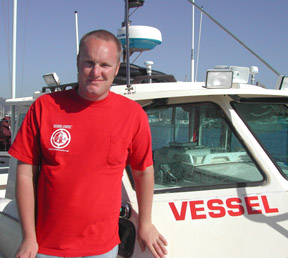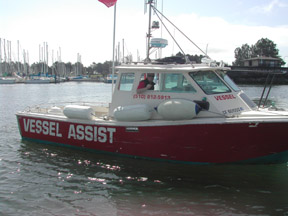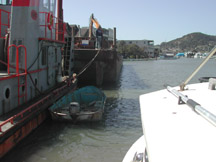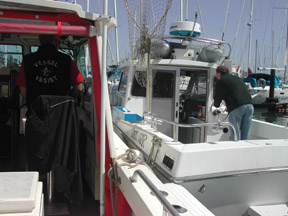 Bay
Crossings Afloat
Bay
Crossings AfloatTowing a Boat
with Captain Brett
By Mary Swift-Swan
The engine cannot start. It is 2 a.m. with
no other boats around. A weak 1-3 knot breeze is all we have
to sail in to hold our position against a quickly building
ebb current in nearly 300 feet of water outside the Gate.
The rushing waters are already starting out pushing us back
out to sea. Who do you call? Vessel Assist. Getting up out
of a warm bed, driving to the Marina, and jumping into a
boat for two hours to provide a jump to a weak battery might
make a regular guy grumpy. Not the Captain of San Francisco
Bay’s boating assistance service. By 4 a.m., we were safely
anchored by Angel Island with the engine purring as it
charged the depleted batteries. The towboat driver escorted
us in on his way back to home port and left with a final
wave. It is nice to have a friend on the water who is there
24/7.
 What
is it like to be on the other end as an operator for a
recreational boating tow service? To find out, Bay Crossings
went afloat with Captain Brett Eller, manager of San
Francisco Bay for Vessel Assist/Boat US for a scheduled tow.
After being welcomed aboard the clean and shipshape towing
vessel, we headed out from the Berkeley Marina across the
Bay to the Sausalito harbor to help a power boat owner get
his vessel to a mechanic in San Rafael, then back to
Berkeley. Towing fees begin at the port of origin and end
when the towboat returns to its home port.
What
is it like to be on the other end as an operator for a
recreational boating tow service? To find out, Bay Crossings
went afloat with Captain Brett Eller, manager of San
Francisco Bay for Vessel Assist/Boat US for a scheduled tow.
After being welcomed aboard the clean and shipshape towing
vessel, we headed out from the Berkeley Marina across the
Bay to the Sausalito harbor to help a power boat owner get
his vessel to a mechanic in San Rafael, then back to
Berkeley. Towing fees begin at the port of origin and end
when the towboat returns to its home port.
Underway, we talked of what it is like being a towing
Captain.
BC: Do people you help appreciate what you do for them?
CBE: That is a touchy subject because for some people you
can’t get there fast enough. Some are disappointed with a
15-minute ETA or they are out on the Tuna grounds, 50 miles
out and can’t understand why it would take four hours to get
to their location. Other people are very appreciative. I do
make tips, (he smiled), and get a lot of verbal appreciation
and praise too, such as compliments on my boat handling.
BC: What do you like about this work?
CBE: What I like about it is that it is very fast paced.
Even though when towing someone you are making no more than
6 or 7 knots (1 knot=1.15 land miles per hour, 7 kn=8 mph),
both radios might be talking, and two cell phones going, all
talking to you about cases. You see something new every day.
The weather is always different. The situations are always
different. No two days are alike. The first call in the
morning is always different. The job is pretty cool. It
doesn’t usually get boring. What is boring to
me is a tow from San Francisco to Stockton, which is a
14-hour tow.The USCG doesn’t allow towing for more than
eight hours without two Captains, so it is usually
accomplished in two days. That makes for easy days but I’d
rather be in San Francisco Bay with three calls stacked on
top of one another, running from one situation to the next.
Weekdays are mixed with scheduled tows, but weekends are
always busy.
Brett was a “Pinhead” who traded washing boats for the
chance to go fishing on charter boats at age 11. He was
hired as a deckhand at 13. When still under 18, he was given
the opportunity to learn to drive the 65-foot fishing
charter boats. Brett became quite good at it. He took the
tests and was given his first Captain’s license at 18, which
is very special. USCG regulations on age only allow a
provisional license at 18 normally, making young boaters
wait until 19 for a full license. Brett did not push. The
USCG chose to give it to him. He must have impressed the
station Lieutenant. He graduates from CMA this May with a
3rd Mate’s license. His ultimate goal is to work on tractor
tugs either in Long Beach, San Francisco Bay, or Puget
Sound. “Maybe later in life I’ll be a Harbor Pilot, but tugs
are my first love.”
Captain Brett is impressive. At “nearly 23,” Brett has
worked for Vessel Assist for close to four years after
officially driving the Fishing boat for one year. When he
decided he wanted to do more with boats, he enrolled at Cal
Maritime in Vallejo. Originally from Southern California, he
is a self-proclaimed fair-weather boater. Days he loves best
are the sunny and pleasant days with lots of action to keep
it interesting. “Heavy weather days are simply more work for
everything we do.”
As manager for the San Francisco Bay fleet, he coordinates
up to six part-time Captains on any given weekends with all
boats very busy. The newest Captains are given the long
tows. “It is less confusing for them than trying to deal
with multiple cases at first. That gives them a chance to
settle in and make a good days wage for their time.”
 BC:
What are some of the more interesting calls for assistance?
BC:
What are some of the more interesting calls for assistance?
CBE: Just last weekend I got a call up
in Suisun Slough for a guy with a 21’ open bow Sea Ray with
three kids on board and himself. He said he was aground,
which is fine. We handle those. I got to the area where I
thought he was from his description, althought he did not
have a GPS or anything. All I saw was a face peaking out,
pulling the tules to the side. No boat to be seen. The
skipper had been distracted by the kids and launched his
boat up onto the bank clear over to the other side of the
tules. We were able to pull him off. It wasn’t a case of
boat handling that time but it did put our boat to the test
on horsepower getting him out of there, that’s for sure. He
had three sons on board. They were fine. He had a nick on
the bridge of his nose from the dash. It was a glide up on
the hill more than a collision. Good thing it was tulles and
not rocks. It is something different every day.
Last Sunday in the Delta, a guy had been blown up on the
levy in the night when his anchor dragged. He called his
buddy in the morning to help him off. It was rough and
windy. His buddy ended up swamping his boat trying. When we
arrived, we had a boat on the levy, and one sunk below him.
Both were 20-21-foot runabouts. We do salvage, too, so we
helped both boats. It was still rough, so it is was a bit of
a challenge.
I rode up on a guy responding to a call
because of a dead battery. He was inside the Duxbury Reef
(north of Stinson Beach). He had no idea what kind of
situation he was in. If his anchor had dragged... We had to
have the park service with their inflatable pull him out
through the breakers because we could not go in there. After
he was out, we were able to help him with a battery jump and
get him on his way, a bit wiser.
I’ve seen some people put some big ol’
boats aground. There are a lot of groundings every minus
tide including some beautiful boats. People pay millions for
their boats, yet they don’t pay $30 for the chart or learn
to navigate with one to see where they are going.
We get quite a few calls with dismasted
sailboats. At least one a month. If the mast is hanging over
the side of the boat, there is not much we can do other than
let them use our bolt cutters to cut it free. If it happens
in a shallow area like in the Berkeley Circle we can tie a
marker to it and retrieve it when the conditions that caused
the dismasting calm down. The important thing is to save the
boom and get rid of the mast quickly so it does not do any
damage to the hull. A rough broken spar can put a hole in a
fiberglass boat without much problem. Many sailors have bolt
cutters of size for their rigging and hacksaws aboard so
once they have cleared their masts, their engine is fine so
we never hear from them. We only get those calls about once
a month.
 Off
Belvedere Point, we had a call from a frantic client. We
were dispatched and got there within 20-25 minutes. The
caller was so frantic the dispatcher couldn’t really get an
idea what was wrong. When we got on the scene, the jib was
whipping around but the boat looked sound. The owner
couldn’t get the boat to go up into the wind to get the wind
out of the sail because every time he’d try, the sail would
catch wind and push him into a spin. I finally got close
enough to talk to him. I asked what was wrong. He said, “My
automatic roller furler is not working.” I called back,
“Can’t you drop the sail to the deck?” and he replied, “I
don’t know. Can I?” I said, “I think so.” Not being a
sailor, I have learned a lot about sailing with this job. It
worked, but we escorted him to his nearby berth because he
was shaken up realizing that by not knowing he could just
motor up into the wind and drop the sail, he’d spent all
that time dodging boats and rocks being tossed around in
20-25 knots of wind.
Off
Belvedere Point, we had a call from a frantic client. We
were dispatched and got there within 20-25 minutes. The
caller was so frantic the dispatcher couldn’t really get an
idea what was wrong. When we got on the scene, the jib was
whipping around but the boat looked sound. The owner
couldn’t get the boat to go up into the wind to get the wind
out of the sail because every time he’d try, the sail would
catch wind and push him into a spin. I finally got close
enough to talk to him. I asked what was wrong. He said, “My
automatic roller furler is not working.” I called back,
“Can’t you drop the sail to the deck?” and he replied, “I
don’t know. Can I?” I said, “I think so.” Not being a
sailor, I have learned a lot about sailing with this job. It
worked, but we escorted him to his nearby berth because he
was shaken up realizing that by not knowing he could just
motor up into the wind and drop the sail, he’d spent all
that time dodging boats and rocks being tossed around in
20-25 knots of wind.
There is always a sense of amazement in
Sturgeon fishermen. When they run all their electronics and
all their equipment all night long they are amazed that
their battery is dead in the morning. It seems logical to
me, but I’m just the towboat driver, you know. They go out
for all night or several nights and frequently they are our
first call in the morning.
 One
family was heading out for Cabo San Lucas. They started out
from the Pittsburg Marina. They ended up getting a little
out of the channel because they were distracted. They had
three cats aboard and the cats were all seasick before they
were even a mile and half away from their home port. They
went aground, not hard, but were touching bottom, as they
say. We were able to help them, but we all had to wait a few
hours for the tide to rise before we could safely pull them
free. They were laughing, and it was pretty funny. They were
heading out with a few thousand miles to go and were aground
in the first mile and a half. It felt good to help get them
underway again.
One
family was heading out for Cabo San Lucas. They started out
from the Pittsburg Marina. They ended up getting a little
out of the channel because they were distracted. They had
three cats aboard and the cats were all seasick before they
were even a mile and half away from their home port. They
went aground, not hard, but were touching bottom, as they
say. We were able to help them, but we all had to wait a few
hours for the tide to rise before we could safely pull them
free. They were laughing, and it was pretty funny. They were
heading out with a few thousand miles to go and were aground
in the first mile and a half. It felt good to help get them
underway again.
As we arrived at the harbor,
Brett tried the VHF radio without success. He picked up his
cell and made contact with the boat owner. He had gone for a
run and was almost back. We met at the boat, attracting
helpful attention of four of the owners’ dock neighbors. As
Brett side tied the boat tightly on the “hip” of his tow
vessel, we maneuvered back and forth like getting out of a
tight parking space in a parking lot. Coming close but never
touching, we were underway to calls from the friends, “Great
boat handling Captain.”
Outside the harbor, a tow
line was passed to the owner with a large metal locking hook
attached to the trailer ring under the bow of the boat. When
the owner was back in the safety of the cockpit, we started
out very slowly. After the line stretched out more line was
eased to put the boats “In Step,” which means that each boat
is on the same face of waves, either on the up or down side,
with about six 2-3-foot waves between them so the towed boat
does not run up on the towing vessel. Once underway, the
Vessel Traffic Service was notified that a tow was underway,
our route, and destination. The rest was a pleasant ride
until large wakes hit from a commercial tug. Brett slowed
down but did not stop. Instead, he kept up a slight pull for
the powerboat to get as gently through the wakes as
possible. Once he was sure the owner riding on his own boat
could steer and his lookout was OK, we came back up to
towing speed (half the normal speed of the slowest of boat)
until we came to the San Rafael Channel. Again, the Vessel
Traffic Service was notified. This time reporting in that we
were out of the traffic pattern. We traveled slower up the
narrow channel watching to be sure the tow did not slip to
one side or the other where it might go aground. Just before
going inside the San Rafael channel, the towline was quickly
shortened in the flat water. In the most open spot, about
half way up the channel, the boats circled while they were
again tied tightly together with the towed vessel on the hip
of the towboat. Navigating around a dredge was the only
tight spot, then into Helmut’s Marine docks. The cost was
over $600. The owner thought he had renewed his towing
insurance. He had, but he had renewed with Sea Tow, which
does not have vessels in the Bay.
 Vessel
Assist was purchased by Boat US in 2003. At the start of the
2004 season, the once competing groups, Boat US Tow and
Vessel Assist, had their first joint meeting bringing
together the operators of the combined fleets. Under the
management of the nonprofit group Boat US, this change has
brought together the most comprehensive towing and vessel
aid group in the country. Prior to the purchase, both had
gone national, but Vessel Assist had the largest fleet on
the West Coast where they started and Boat US had the
largest fleet on the East Coast where they started. They
both provided a menu of services for a low annual fees,
depending on service range and features desired. The menus
have merged, adding options but otherwise have not changed.
It is only expected to get better with more coordinated
vessels to serve the boating public. Expecting increased
business, there are more towboats being built for
high-traffic areas like San Francisco Bay. Existing services
include:
Vessel
Assist was purchased by Boat US in 2003. At the start of the
2004 season, the once competing groups, Boat US Tow and
Vessel Assist, had their first joint meeting bringing
together the operators of the combined fleets. Under the
management of the nonprofit group Boat US, this change has
brought together the most comprehensive towing and vessel
aid group in the country. Prior to the purchase, both had
gone national, but Vessel Assist had the largest fleet on
the West Coast where they started and Boat US had the
largest fleet on the East Coast where they started. They
both provided a menu of services for a low annual fees,
depending on service range and features desired. The menus
have merged, adding options but otherwise have not changed.
It is only expected to get better with more coordinated
vessels to serve the boating public. Expecting increased
business, there are more towboats being built for
high-traffic areas like San Francisco Bay. Existing services
include:
24/7 dispatch service
Free Towing for a specified boat
or Captain
Fuel delivery if out of fuel
A battery jump start
Aid for soft groundings
If taking on water, they can bring pumps
Salvage of sunken vessels
A tow without coverage costs between $150 to $200 per hour
and a tow of over 25 miles is generally in excess of $1,000.
One three-hour tow in two years and the annual membership of
$10 to $180 pays for itself. Due to changes that started in
1984, downsizing the USCG, and the sheer volume of calls,
the USCG now only responds to true emergency calls. The U.S.
Coast Guard can only provide aid to boaters when there is a
possibility of sinking or loss of life or an environmental
emergency, real May-Day calls. Pan-Pan or general aid
requests are most often referred to any nearby good
Samaritan boaters who may be able to safely help or any
available local towing company. For more information, call
800 399-1921 or visit www.vesselassist.com or www.boatus.com.